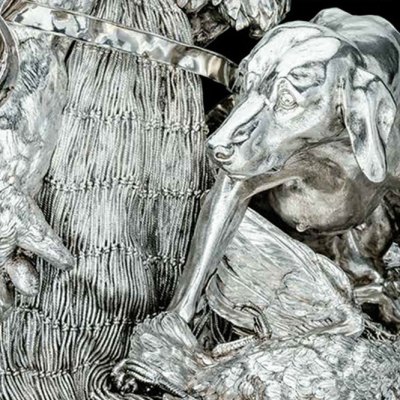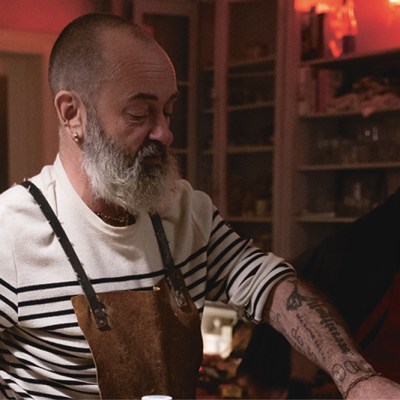From the October 2023 issue of Apollo. Preview and subscribe here.
In the court of pre-Revolutionary France, hunting was October’s most important recreational activity. Complex dishes of game and poultry, the origins of which were in the culture of the chase, were served at autumnal feasts. Perhaps the most celebrated was the pot d’ouile, or olio, a complex mixed stew that emerged in Renaissance Spain before spreading rapidly across Europe. An English recipe for the dish from 1723 reads like an account of a mass extinction. It contains not only a rump of beef, mutton, pork, venison and bacon, but also geese, turkeys, capons, pheasants, wigeons, partridges, and ‘Snipes half a dozen, Quails two dozen and Larks four dozen’. Of equal complexity was the terrine or tureiner, which derived its name from the terracotta pot in which it was baked. These dishes served as emblems of the bounty of the aristocratic host’s parks and pasturelands.
By the late 17th century, French silversmiths were developing specialist vessels for serving these grosses entrées, though by this time the number of ingredients had been trimmed down to suit refined Gallic sensibilities. Some of the earliest to survive are from the workshop of court goldsmith Thomas Germain (1673–1748). These pots d’ouile and terrines are among the most magnificent silver vessels ever made. A pair of tureens made in the late 1720s and now at the Getty features lifelike wild boar head-shaped handles cast in silver. A set from 1745–50 is crowned with covers graced with trompe l’oeil cauliflowers, crayfish and crabs. The aim: to titillate guests’ appetites with realistic depictions of the ingredients of the stew they were about to consume.
Cauliflower lidded tureen, liner and stand (1744–50), Thomas Germain. The J. Paul Getty Museum

One of the mysteries of culinary history is the sudden appearance of these spectacular tureens in the early 18th century. There is little material evidence before this time for the existence of receptacles specifically designed for serving soups and stews. It is often assumed that the tureen’s ancestors were humble terracotta bowls, though none appear to have survived. By contrast, the earliest tureens are far from simple – they are among the most elaborate expressions of the silversmith’s art. Later examples crafted from porcelain were based on the shapes of these silver predecessors.
These impressive items did not crystallise out of thin air. Extravagantly ornamented and gilded food containers with lids had graced tables for centuries before the silver tureen emerged: receptacles made, rather incongruously, of pastry. Pies such as these were not cut into slices. Instead, the pastry lid was carefully cut off and the contents spooned out. They were, in effect, edible tureens – the bird on top identifying the nature of the contents, rather like the crayfish, crab and cauliflower on Germain’s silver tureens. An engraving in a recipe book of c. 1720 by the London pastry cook Edward Kidder depicts a wild boar pie with more than a passing similarity to Germain’s later olio pot. As items that sit outside of familiar categories of design, art historians have long overlooked such edible vessels.
Kitchen Interior (detail; 1644), David Teniers the Younger. Mauritshuis, The Hague

Pies covered in ornamental devices were commonplace on high-status tables in the 16th and 17th centuries, and are frequently depicted in Netherlandish, German and Italian paintings. Kitchen Interior (1644) by David Teniers the Younger features a large pie profusely decorated with gilt strapwork, awaiting delivery to the dining room. The pastry is emblazoned with an Imperial double-headed eagle and surmounted by the head, tail and wings of a swan bedecked in a floral headdress, a bauble in its gilt-covered beak. In a collaborative painting of 1618, The Sense of Taste by Peter Paul Rubens and Jan Brueghel, four similar pies are dressed with taxidermy specimens of a peacock, a pheasant and a partridge. The birds are all dotted with gold leaf – some even wear jewellery – while the pastry cases are covered in gilded patterns.
The Sense of Taste (1618), Jan Brueghel and Peter Paul Rubens. Museo Nacional del Prado

The most notable collection of designs for these astonishing creations is Conrad Hagger’s Neues Saltzburgisches Koch-Buch (1719). Hagger was cook to the Archbishop of Saltzburg and his book includes more than 300 detailed engravings, many of tureen-like pastries. A number are similar to the bird pies painted by Teniers and Brueghel, though Hagger crafts his swans and peacocks entirely from pastry and provides diagrams to show how they can be constructed. Capricious pies depicting lions, griffins or the pelican in her piety are illustrated alongside hare pasteten (pies) with gadrooned pastry sides and acanthus-adorned lids reminiscent of Germain’s chased silver embellishments.
Despite the triumph of the tureen, pastry cooks continued to make decorative tureen-like pies. In an engraving from 1740 of a feast in Vienna in homage to Empress Maria Theresa, an ornamental pie – its top removed and a ladle protruding from its contents – sits next to fashionable pots d’ouile. Pies continued to appear on the same table as their grand silver relatives – a taste of the eclectic attitude that so lavishly furnished the 18th century.
From the October 2023 issue of Apollo. Preview and subscribe here.


